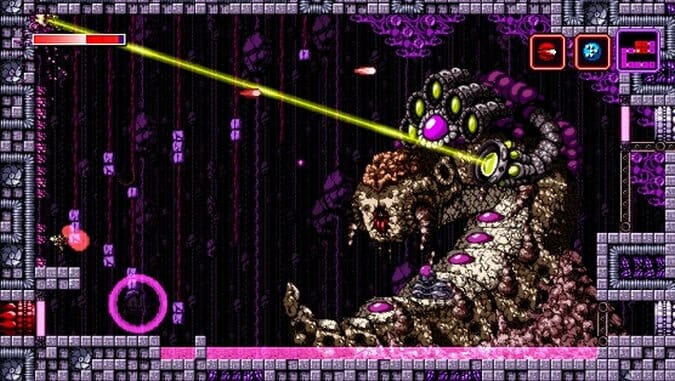Axiom Verge: Incorruptible Nostalgia

Axiom Verge treats information as bacteria, alive and festering. The accident that causes protagonist Trace to fumble into the world of a Metroid game that never was is caused by an experiment gone awry—technological hubris mixed with incompetence. The main villain turns out to be someone thoroughly infested by information, vile with an overload of data. Corrupted data manifests as rotten blobs of broken pixels that block the way to the next objective. To break these barriers, you find a gun that hacks them back into order, as well as bombs that destroy larger masses of glitched goo. These weapons also affect enemies, discombobulating them into broken shapes (be on the lookout for Missingno). Watching these corrupted enemies thrash around is unsettling. What’s it like to be corrupted?
Information is everything in Axiom Verge, but like bacteria it’s as much your savior as it is your enemy. When you die, you’re reconfigured from data, Star Trek-style, and returned to the nearest save point. Those hacking weapons are invaluable and you can’t beat Verge without them. Through the transfer of data, you’re able to supplant your conscious into a drone (Verge’s version of the Morph Ball) and move independently of your own body. Trace constantly asks for information about where he is and what’s happening to him from Elsenova, his robotic guide, only to receive deflections and misdirection, which allows her to manipulate him for her own needs.
Information—how it’s distributed, how it misleads, how it creates—is Verge’s key message. One of its best parts involves Trace entering a section of the world that makes him delirious, making it hard for him (and the player) to understand just what is happening. You’re not sure where you are, what is or isn’t an enemy and the section ends with a boss battle I only made sense of after the fact (others will probably pick up on it sooner). These moments are rare, but they drive home a point: what you know (and what you don’t) is everything.
With every boss you kill and every area you open up, you gain a slice of information about what’s going on with Trace and Elsenova, a new weapon to access more areas. Here, too, information is invaluable, infectious. As soon as I found a secret with a new toy, I’d become addicted to finding more hidden weapons, more knowledge, more weapons. It doesn’t help that, like heart containers, health and damage upgrades are split into pieces, making it all the more tempting to disregard my main objective and continue scouring. Some secrets are literally just information—logs about what may have happened, theories about everything. Some aren’t even in readable languages. That doesn’t matter much. I want as much information as I could get.
I couldn’t find every piece of equipment or fill out the whole map, but I desperately tried. I wanted to know where every little secret was. At one point, I hit a big wall in the main quest (the solution was painfully obvious in hindsight). Rather than bang my head against it, I decided this was the perfect time to go back and look for anything I may have missed. Secrets are hard to find, and occasionally hard to get. With a few early exceptions, breakable blocks are never visually obvious, and some secrets are nested: reveal a secret path to a hidden world (usually glitches are made up from parts of other environments), then find the secrets therein.
Information also haunts Axiom Verge as a cultural artifact, or at least history does. “Harkening back to the classics” always felt like a mantra that betrayed a certain lack of confidence. Experiencing every “oh yeah, I remember that” in I Wanna Be The Guy, every ham-fisted homage in Super Meat Boy, every on-the-sly appeal to nostalgia of Cave Story, I couldn’t help but think something about those games smelled of overcompensation. When it comes to nostalgia trips, the good ones differentiate themselves by excelling regardless of the strength of their inspirations, not because of them. Why burden yourself by inviting comparisons to titles the gaming consciousness has already deified? Nostalgia is just another form of information, and it’s just as infectious.
Yet Axiom brims with confidence. It doesn’t ask whether what it’s doing is good enough, if it evokes enough of its ancestry to appeal. It knows it will pass muster as a nostalgia piece then goes about its business. It’s unapologetic in reproducing Super Metroid, top to bottom; my first couple of hours as Trace felt like a game of nostalgia chicken. The more I played it, the more it was like Super Metroid. I found a drill weapon, which isn’t something you’d find in Super Metroid, but it effectively acted like Morph Ball bombs. I didn’t think it would then dare to give me an actual morph ball equivalent, but then there it was, the drone.
As I dared Verge to be more like Super Metroid, it proved up to the challenge almost every time. By the endgame, armed with a collection of weaponry from drills to drones to hacking guns to ice machine-guns to wall-phasing that felt like a fusion of the space jump and the speed booster run, all I could think about was how there weren’t enough of them, not enough secrets. I needed more knowledge under my belt.
Where other homages in a similar vein find a basic outline of Metroid then take their own spin on it, Axiom Verge runs with its inspiration from beginning to end. The differences are hyper-specific: the morph ball is replaced by a drone; there’s no charge shot or missiles with ammo, but rather a variety of weapons made solely for combat; specific gadgets act as your keys to finding those all-important secrets. You won’t upgrade ammo counts, but instead you’ll find upgrades to damage and weapon radii. That Verge doesn’t otherwise stray too far from its inspiration is its beauty.
Axiom Verge’s mitosis also extends to Metroid’s structure, and this is key to its success. When I say that other games take the inspiration and find a new spin on it, it’s usually a single new idea, which they then focus on by making the rest of their structure more rigid in order to maximize the appeal of their twist. Verge’s “spin” is its slavish dedication, and the openness that comes with this follow-through is what so many other copycats have been missing. There’s more to this than how many paths you can wander down at any given point. Super Metroid was as much about getting lost, about the moments where you didn’t know what path to head down. It was about hitting every pixel with every weapon you had to see if you could find the way forward.
As with Elsenova with Trace, Verge is careful in doling out information, giving you just enough to get by. Despite never being led by the nose, I only ever got stuck in a major way once. This resulted in some of the heaviest doses of nostalgia I’ve had in recent memory, as I ran around for hours to fill every square of the map I hadn’t been too yet, looking for direction but finding secret after secret instead.
-

-

-

-

-

-

-

-

-

-

-

-

-

-

-

-

-

-

-

-

-

-

-

-

-

-

-

-

-

-

-

-

-

-

-

-

-

-

-

-








































